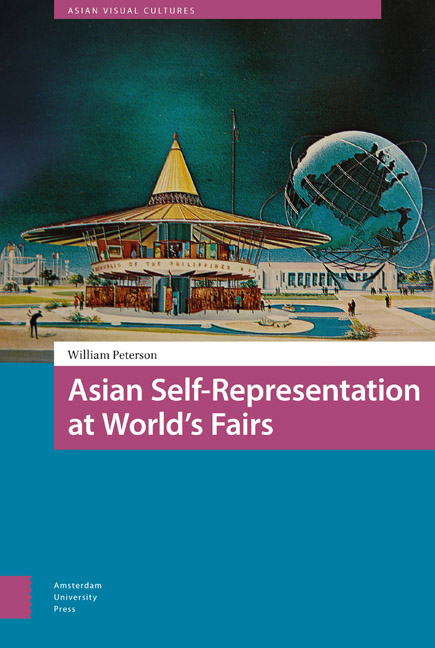Book contents
- Frontmatter
- Dedication
- Contents
- List of Figures
- Acknowledgements
- Note on Works Cited
- Note on Asian Names
- 1 Introduction: Setting the Stage
- 2 The Master of the Form: Japan at San Francisco's 1915 Panama-Pacific International Exposition
- 3 The New China and Chinese-Americanness: China at San Francisco's 1915 Panama-Pacific International Exposition
- 4 Performing Japan in the ‘World of Tomorrow’: Japan at the 1939-1940 New York World's Fair
- 5 From ‘Panda Diplomacy’ to Acrobat Diplomacy: China at the Brisbane's Expo ‘88
- 6 Fashion, Dance, and Representing the Filipina: The Philippines at the 1964-1965 New York World's Fair
- 7 Performing Modernity under Sukarno's ‘Roving Eye’: Indonesia at the 1964-1965 New York World's Fair
- 8 Maximizing Affect, Minimizing Impact with Hansik: South Korea at the 2015 Milan International Exposition
- 9 Hard and Soft Power in the Thai Pavilion: The Spectral Presence of King Bhumibol at the 2015 Milan Exposition
- 10 Conclusion: The Future of Asian Self-Representation at the International Exposition
- Works Cited
- Index
10 - Conclusion: The Future of Asian Self-Representation at the International Exposition
Published online by Cambridge University Press: 21 November 2020
- Frontmatter
- Dedication
- Contents
- List of Figures
- Acknowledgements
- Note on Works Cited
- Note on Asian Names
- 1 Introduction: Setting the Stage
- 2 The Master of the Form: Japan at San Francisco's 1915 Panama-Pacific International Exposition
- 3 The New China and Chinese-Americanness: China at San Francisco's 1915 Panama-Pacific International Exposition
- 4 Performing Japan in the ‘World of Tomorrow’: Japan at the 1939-1940 New York World's Fair
- 5 From ‘Panda Diplomacy’ to Acrobat Diplomacy: China at the Brisbane's Expo ‘88
- 6 Fashion, Dance, and Representing the Filipina: The Philippines at the 1964-1965 New York World's Fair
- 7 Performing Modernity under Sukarno's ‘Roving Eye’: Indonesia at the 1964-1965 New York World's Fair
- 8 Maximizing Affect, Minimizing Impact with Hansik: South Korea at the 2015 Milan International Exposition
- 9 Hard and Soft Power in the Thai Pavilion: The Spectral Presence of King Bhumibol at the 2015 Milan Exposition
- 10 Conclusion: The Future of Asian Self-Representation at the International Exposition
- Works Cited
- Index
Summary
Abstract
While diminished audience numbers and the impossible scale of resources required to successfully pull off international expositions over the last fifty years suggests that their days are numbered in the West, the extraordinary draw of the 2010 Shanghai Expo (73.1 million) demonstrates that the form is far from dead. The massive resources that flowed into that expo and the 2020 Dubai Exposition would suggest that top-down economies, ones where the state functions as the seat of corporate power, can create an attractive platform for any ambitious nation to seek out a seat at the table. The future of representation at world's fairs may thus be more about ‘nationalising the sell’ than representing nation.
Keywords: Dubai Exposition, Osaka Exposition, Chinese allure
The 2015 Milan Exposition makes clear that the grand European exposition as a national project is unlikely to be revived anytime soon. Perhaps the bleakest assessment on the exposition form came from British architecture and design critic Oliver Wainwright. Writing for The Guardian before the expo ended, he argued that in the wake of two disastrous prior European expos, Seville's Expo 92, which left the city deeply in debt, and the poorly-attended Hanover 2000, ‘it seems clearer than ever that the format of the world exposition is well past its expiry date, leaving a trail of debt and destruction wherever it strikes’ (2015). The massive cost-overruns of the Milan Expo, which blew the budget out to €1.3 billion, the unsightly unfinished pavilions that required a €1 million to conceal (Cameron 2015), and the full-scale anti-Expo rioting on the streets of Milan at the time of its opening made this one of the most fraught and criticized international expositions in history. Milan Expo master planner Jacques Herzog spoke out against way the expo was executed in the post-design phase, characterizing it as a ‘vanity fair,’ (Heilmeyer 2015, p. 54) while even Pope Francis weighed in, responding to the fair's theme of ‘Feeding the Planet’ with the observation that the Expo itself is part of a ‘paradox of abundance’ that ‘obeys the culture of waste and does not contribute to a model of equitable and sustainable development’ (Day 2015). With 21.5 million visitors, Milan's Expo attracted only a few million people more than Hanover's (2000), and a number of European nations chose not to participate, suggesting that fully international fairs in Europe may no longer be viable.
- Type
- Chapter
- Information
- Asian Self-Representation at World's Fairs , pp. 279 - 294Publisher: Amsterdam University PressPrint publication year: 2020

